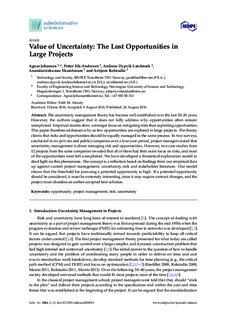| dc.contributor.author | Johansen, Agnar | |
| dc.contributor.author | Eik-Andresen, Petter | |
| dc.contributor.author | Landmark, Andreas D. | |
| dc.contributor.author | Ekambaram, Anandasivakumar | |
| dc.contributor.author | Rolstadås, Asbjørn | |
| dc.date.accessioned | 2019-03-01T08:22:27Z | |
| dc.date.available | 2019-03-01T08:22:27Z | |
| dc.date.created | 2016-08-28T14:42:36Z | |
| dc.date.issued | 2016 | |
| dc.identifier.citation | Administrative Sciences. 2016, 6 (3), pp 17 | nb_NO |
| dc.identifier.issn | 2076-3387 | |
| dc.identifier.uri | http://hdl.handle.net/11250/2588172 | |
| dc.description.abstract | The uncertainty management theory has become well established over the last 20–30 years. However, the authors suggest that it does not fully address why opportunities often remain unexploited. Empirical studies show a stronger focus on mitigating risks than exploiting opportunities. This paper therefore addresses why so few opportunities are explored in large projects. The theory claims that risks and opportunities should be equally managed in the same process. In two surveys, conducted in six (private and public) companies over a four-year period, project managers stated that uncertainty management is about managing risk and opportunities. However, two case studies from 12 projects from the same companies revealed that all of them had their main focus on risks, and most of the opportunities were left unexploited. We have developed a theoretical explanation model to shed light on this phenomena. The concept is a reflection based on findings from our empirical data up against current project management, uncertainty, risk and stakeholder literature. Our model shows that the threshold for pursuing a potential opportunity is high. If a potential opportunity should be considered, it must be extremely interesting, since it may require contract changes, and the project must abandon an earlier-accepted best solution. | |
| dc.language.iso | eng | nb_NO |
| dc.rights | Navngivelse 4.0 Internasjonal | * |
| dc.rights.uri | http://creativecommons.org/licenses/by/4.0/deed.no | * |
| dc.title | Value of Uncertainty: The Lost Opportunities in Large Projects | nb_NO |
| dc.type | Journal article | nb_NO |
| dc.type | Peer reviewed | nb_NO |
| dc.description.version | publishedVersion | |
| dc.source.pagenumber | 17 | nb_NO |
| dc.source.volume | 6 | nb_NO |
| dc.source.journal | Administrative Sciences | nb_NO |
| dc.source.issue | 3 | nb_NO |
| dc.identifier.doi | 10.3390/admsci6030011 | |
| dc.identifier.cristin | 1376019 | |
| dc.relation.project | Norges forskningsråd: 235160 | nb_NO |
| cristin.unitcode | 7401,60,55,0 | |
| cristin.unitname | Teknologiledelse | |
| cristin.ispublished | true | |
| cristin.fulltext | original | |
| cristin.qualitycode | 1 | |

